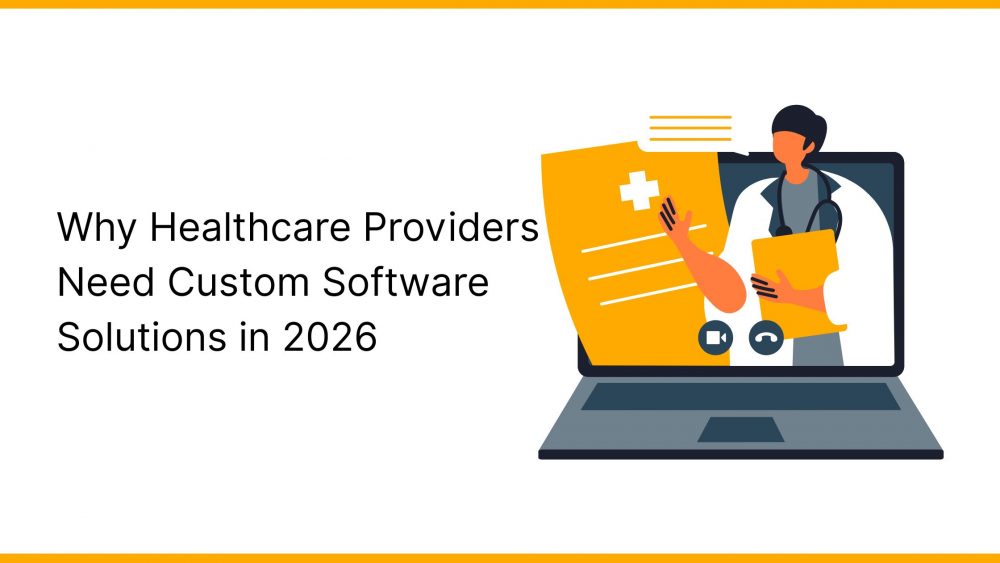
Healthcare is changing faster than ever before. Technology has become the lifeline of hospitals, clinics, and care networks across the world. Patient records, billing systems, diagnostics, and even remote care now depend on digital tools. Yet, beneath all this progress lies a silent truth — most healthcare providers are still working with rigid systems that do not fit how they actually deliver care.
Every year brings new rules, new patient demands, and new technologies. Data must flow freely between devices and departments. Regulations grow tighter. Patients want access, speed, and transparency. In this environment, the old way of managing healthcare — using one-size-fits-all software — no longer works. These systems slow teams down. They break under the weight of integration. They miss the nuances of real-world clinical workflows.
That’s why 2026 marks a decisive moment for the healthcare industry. The race is no longer about adopting technology. It’s about adopting the right technology. A system built not for everyone, but for you. A platform that understands your staff, your patients, your methods, and your mission. That is where custom healthcare software development services come in.
Custom solutions are not just tools; they are extensions of how care happens. They help doctors see patterns earlier. They give nurses the time to focus on people, not paperwork. They let administrators make faster decisions without drowning in data. In short, they turn complexity into clarity.
The next wave of healthcare transformation will not be led by big, generic platforms. It will be led by organizations that build systems around their own vision of care. Custom software makes that possible. It offers freedom, control, and precision in a world that demands all three.
This is not just an upgrade. It’s survival in a digital era where speed, safety, and personalization decide success.
The Shift in Modern Healthcare
Hospitals once ran on paper and routine. Now they run on data. Every click, scan, and appointment tells a story. But many providers still rely on software that was never built for them. Systems that don’t talk to each other. Platforms that slow the very people they’re meant to help.
Custom software changes that. It bends to fit the way doctors, nurses, and patients work—not the other way around.
In 2026, the pressure is real:
- New data laws demand full compliance.
- Remote care grows faster than physical visits.
- Patients expect instant access to their records.
- Hospitals must manage costs while doing more with less.
No off-the-shelf tool can handle all that.
Why Custom Healthcare Software Is Now Essential
Generic healthcare software can only go so far. It follows templates, not people. It serves many, but fits few. As healthcare enters 2026, that approach no longer works. Every provider has unique workflows, patient groups, and compliance needs that can’t be solved by pre-built systems.
Custom software steps in where standard tools stop. It molds technology around care, not care around technology. It connects departments, simplifies communication, strengthens data security, and helps patients feel seen.
In a world driven by precision medicine and real-time decisions, customization is no longer a luxury—it’s the backbone of modern healthcare delivery.
To Match Complex Workflows
Every clinic runs differently. A cardiology center does not work like a dental office. A rural clinic doesn’t face the same load as a metro hospital. Yet most standard software assumes all healthcare works the same.
Custom systems map to your process. They cut extra steps. They automate what slows people down. Scheduling, billing, diagnostics, discharge—everything connects.
The goal is simple: fewer clicks, faster care.
To Protect Data and Follow the Law
Data in healthcare is not just information. It’s life.
A single breach can destroy trust and invite penalties. Compliance rules—HIPAA, GDPR, or others—change every year. Pre-built tools often chase these updates. Custom systems build compliance into the code itself. Role-based access, encryption, and audit trails become part of the structure.
It’s not just security. It’s peace of mind.
To Improve Patient Experience
Patients today don’t want to wait. They book online, track prescriptions, talk to doctors on screens.
A custom app lets them do all that in one place. It syncs with lab results, sends reminders, manages follow-ups. For chronic care or home monitoring, it connects wearables and health devices.
Patients stay involved. Doctors stay informed. Care becomes personal again.
To Reduce Costs and Boost Efficiency
Custom software costs more to build. But it costs less to run. It avoids licensing fees, cuts repetitive work, and removes systems that don’t talk to each other.
Hospitals that invest once save for years. They also scale faster. When patient volume grows or services expand, the software grows too. No need for replacement.
Efficiency is not magic—it’s good design.
To Stay Ready for the Future
Healthcare does not wait. AI now reads scans. Robots assist in surgery. Predictive analytics spot illness before symptoms show.
A custom-built system can plug these tools in without breaking down. It’s flexible. It adapts. Off-the-shelf products don’t.
In 2026, the future belongs to systems that learn.
How Custom Healthcare Software Development Works
Every successful project follows a method — a deliberate path that connects vision to result. When healthcare providers choose custom solutions, they aren’t buying code; they are building a framework that fits their daily reality.
Here’s how it happens.
Step 1: Discovery
It starts with a table. Doctors and developers sit together. They talk. Not about features, but about problems. What slows you down? Where do errors happen? What do patients wait for too long?
They map every workflow. They find the gaps. They turn needs into goals — faster check-ins, cleaner data, fewer clicks. Nothing extra. Nothing wasted.
Discovery gives shape to the idea. It turns confusion into direction.
Step 2: Design
Design is not decoration. It is function made clear. Every button, every color, every field has meaning. The interface must feel natural, not forced.
Designers study how staff move through screens — how a nurse updates vitals, how a doctor reviews notes. They make sure the flow feels like work, not a chore. The aim is speed, not show.
Good design disappears. It just works.
Step 3: Development
Now the build begins. Developers write code like architects lay bricks — steady, tested, exact.
Each module serves a task: scheduling, billing, reporting, telemedicine. They connect everything. They make sure the system speaks to existing tools — lab data, EHRs, patient apps.
Testing happens as they build. Security, speed, accuracy — nothing left to chance. The code must hold up under pressure, just like the people who’ll use it.
Step 4: Training
Even the best system fails without understanding. Staff learn it hands-on. They click, explore, ask questions.
Trainers walk them through real cases — how to log a patient, run a report, send alerts. Mistakes are part of the learning. Feedback shapes the final version.
When people see how it helps them, resistance fades. Confidence takes its place.
Step 5: Support
Launch is not the end. It’s where growth begins.
Support teams watch the system after rollout. They fix bugs, improve speed, add new features. As the clinic grows, the software grows with it. When laws change, updates follow.
Custom software is alive. It adapts. It learns from every click.
Real Results from Real Use
A small city hospital replaced three outdated systems with one custom platform. Waiting times dropped by 30%. Errors fell by half.
A private clinic built a telehealth app tied to its records. It tripled patient reach without hiring more doctors.
A cancer center created its own data dashboard. It predicts patient readmission rates, improving planning and reducing strain.
Each story proves the same truth. Custom solutions don’t just make work easier—they make care better.
Choosing the Right Healthcare Software Development Partner
A good custom healthcare software development service is not just a coder. It’s a listener.
Choose a team that understands healthcare—how clinics run, how records flow, what regulators demand. Ask them how they build for security. Ask how they scale. Ask who owns the code when the work is done.
Transparency matters as much as skill.
Look for:
- Proven healthcare projects.
- Deep knowledge of standards like HL7 and FHIR.
- A team that offers training, not just delivery.
- A roadmap for updates, not just deployment.
This is not a short-term job. It’s a long partnership.
Challenges Along Healthcare Software Development
No build is perfect.
Custom software takes time. Planning takes effort. You’ll face pushback from staff who fear change. Testing will take longer than expected.
But every challenge pays off once the system runs. The key is commitment—to clarity, not complexity.
Hospitals that skip this step spend more later fixing what was never built right.
The Healthcare Software Development Cost Question
Money always matters. Custom systems can start from $25,000 for a clinic and reach $200,000 for a hospital network. Costs depend on size, features, integrations, and security depth.
But think long-term. Standard software charges per user, per month, forever. Custom software charges once and grows with you. Over five years, most providers spend less—and own more.
Ownership is power.
The Future Ahead
In 2026, digital healthcare is not about trends. It’s about trust. Providers who build their systems around patients will lead. Those who wait for “the right time” will lose ground.
Custom systems will soon power every step of care—diagnosis, follow-up, prevention, and beyond. They’ll connect devices, AI models, and data clouds in real time.
The line between technology and medicine will fade. What remains is connection—between people, data, and outcomes.
Final Thought
Healthcare has always been personal. Software should be too.
A patient’s story deserves a system built around it—not a product sold to everyone else. With custom healthcare software development services, providers build more than code. They build trust.
In a world where time defines life, custom software saves both.






